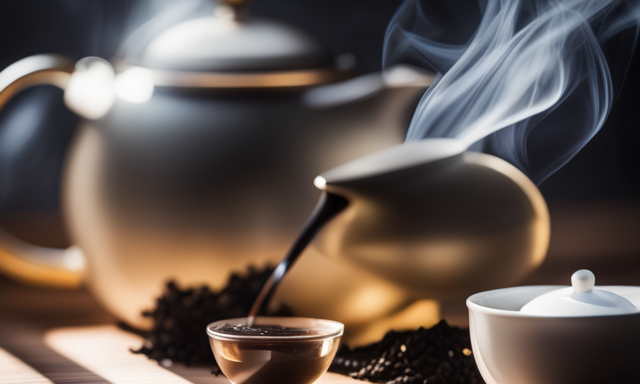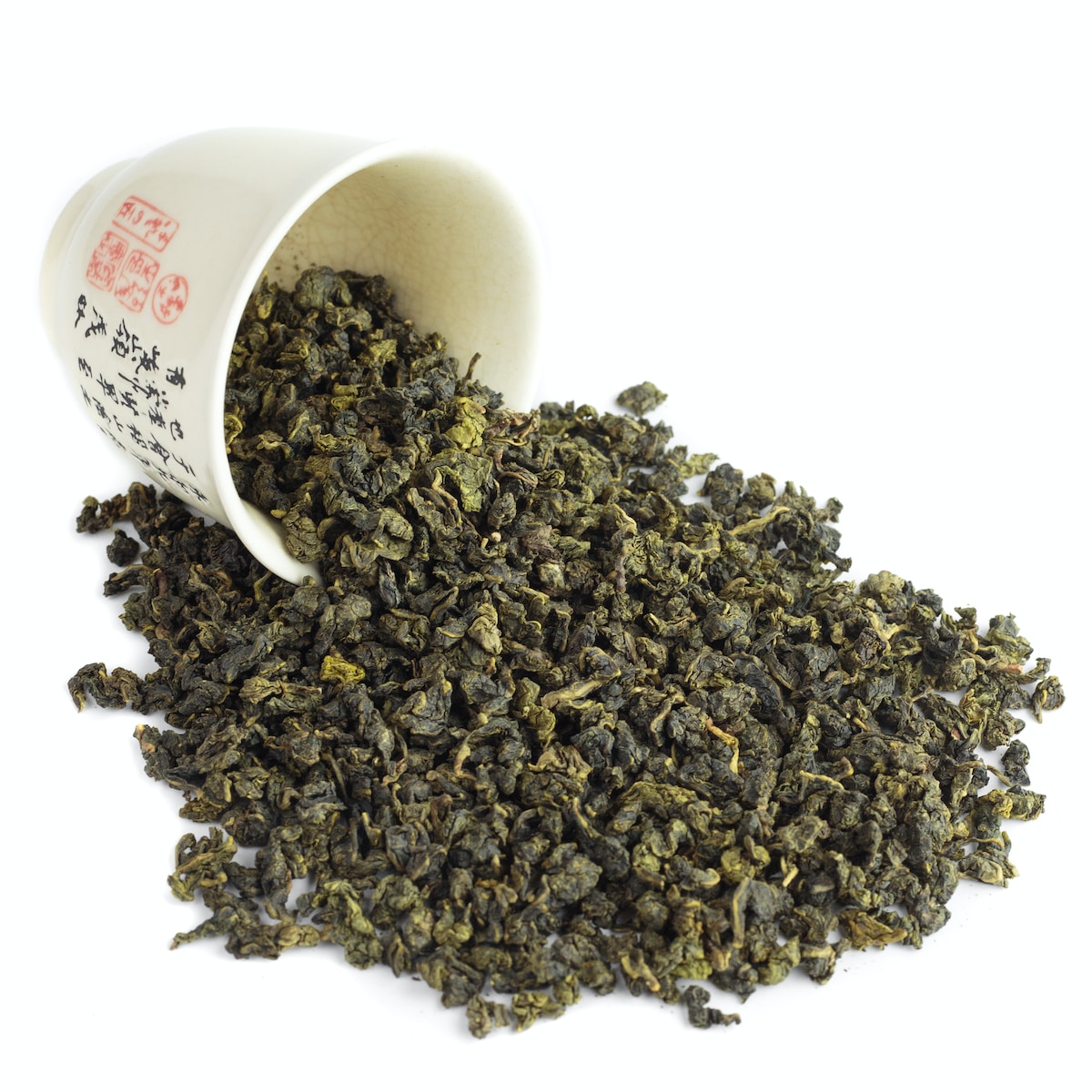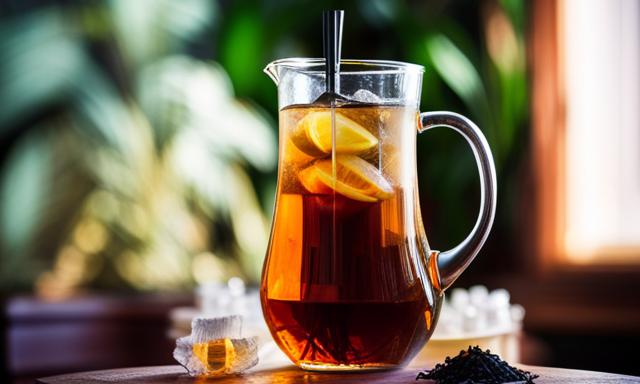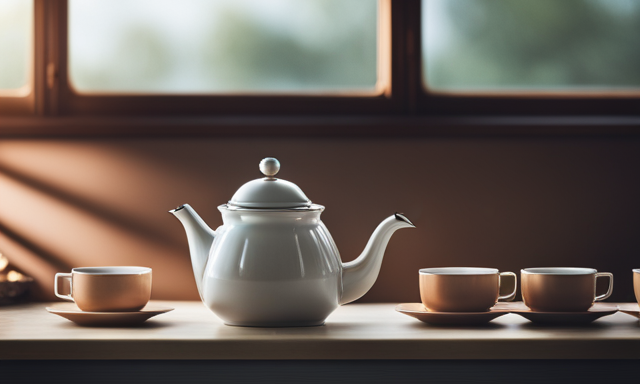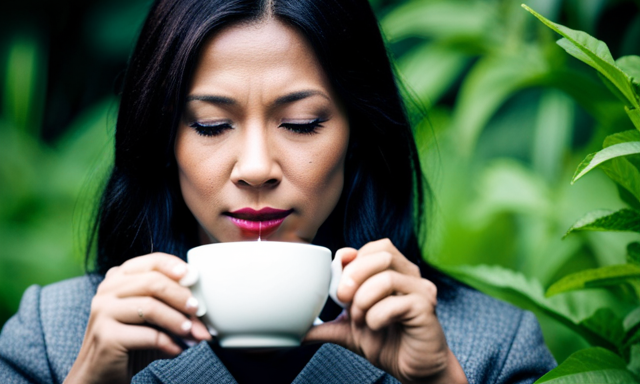Brewing oolong loose leaf tea is like embarking on a sensory journey, where every sip transports you to a world of rich flavors and captivating aromas. As a passionate tea enthusiast, I am thrilled to share my knowledge and expertise on how to brew the perfect cup of oolong tea.
Oolong tea, with its fascinating history and intricate processing methods, offers a delightful balance between the boldness of black tea and the delicacy of green tea. Its flavor profiles can range from floral and fruity to toasty and nutty, making it a versatile and captivating brew.
In this article, I will guide you through the art of brewing oolong loose leaf tea, from selecting the finest tea leaves to mastering the perfect steeping technique. Prepare to unlock the secrets of oolong tea and elevate your tea-drinking experience to new heights.
So, grab your favorite teapot, and let’s embark on this oolong adventure together.
Key Takeaways
- Adjust steeping time and water temperature for different flavors
- Different brewing vessels affect taste and aroma
- Experimentation leads to new discoveries in taste and aroma
- Use airtight containers to protect from air, moisture, and odors
Choose the Right Oolong Tea Leaves
Now, let’s find the perfect oolong tea leaves to make your brewing experience truly delightful! As a tea sommelier, I have a deep understanding of oolong loose leaf tea. This includes its origins, processing methods, flavor profiles, and brewing techniques.
Oolong tea comes in various types, each offering a unique taste and aroma. Some popular varieties include Tie Guan Yin, Da Hong Pao, and Oriental Beauty.
Tie Guan Yin is known for its floral fragrance and smooth, mellow flavor. Da Hong Pao has a rich, roasted taste with hints of fruit and honey. Oriental Beauty offers a sweet and fruity aroma with a delicate, honey-like taste.
When brewing oolong tea, it’s important to use the right type of leaves to achieve the desired flavors and aromas.
Now, let’s move on to the next step and learn how to measure the tea leaves accurately.
Measure the Tea Leaves
To get the perfect cup of oolong tea, start by scooping a generous amount of the leaves into your infuser, like sprinkling a handful of stardust into a magical potion. Proper measurement of tea leaves is crucial to achieve the desired flavor and aroma. Here are three measuring techniques that will ensure accurate measurements:
-
Spoon Method: Use a teaspoon to measure one teaspoon of oolong tea per cup.
-
Weight Method: Weigh 2-3 grams of tea leaves for every 8 ounces of water.
-
Eyeing Method: Develop a keen eye to estimate the right amount of tea leaves based on your personal preference and experience.
Accurate measurements are important because they determine the strength and balance of flavors in your brew.
Now that you have the perfect amount of tea leaves, let’s move on to preparing the water for brewing.
Prepare the Water
First, make sure you have the perfect cup of oolong tea by preparing the water just right. As a tea sommelier, I understand the importance of choosing the right temperature and using filtered water to enhance the flavor and aroma of oolong loose leaf tea.
Oolong tea is delicate and requires a lower water temperature compared to other teas. The ideal temperature for brewing oolong tea is around 180°F (82°C). This temperature allows the leaves to unfurl slowly, releasing their complex flavors and fragrances.
Using filtered water is crucial to avoid any impurities that can affect the taste of the tea. By incorporating these steps, you can ensure that your oolong tea brews to perfection, capturing the unique characteristics of this remarkable tea.
Now, let’s move on to the next step and preheat your teapot or cup.
Preheat Your Teapot or Cup
Before you start, make sure to preheat your teapot or cup to enhance the brewing process and maintain the optimal temperature for your oolong tea.
As a tea sommelier, I understand the importance of using the right teapot for brewing oolong loose leaf tea. There are various teapot types, such as Yixing clay teapots or porcelain teapots, each offering unique benefits for extracting the full flavor and aroma of oolong tea. The choice of teapot material also plays a vital role in the brewing process.
Porcelain teapots, for example, are known for their excellent heat retention and ability to preserve the delicate flavors of oolong tea. By preheating your teapot or cup, you create an ideal environment for steeping the tea leaves, allowing them to unfurl and release their exquisite flavors and fragrances.
Now, let’s move on to the next step and explore how to steep the tea leaves.
Steep the Tea Leaves
Now, let’s dive into the process of steeping your tea leaves and savoring the rich flavors that await you. To fully enjoy the exquisite taste of oolong loose leaf tea, it is crucial to control the water temperature and use a tea infuser. Here are three key steps to help you make the perfect cup of oolong tea:
-
Start by heating water to a temperature between 180°F and 200°F. This range is ideal for oolong tea, as it allows the leaves to unfurl and release their complex flavors without becoming bitter.
-
Place the desired amount of oolong tea leaves into a tea infuser. The infuser will allow the leaves to expand and infuse the water, maximizing flavor extraction.
-
Gently pour the hot water over the tea leaves and let them steep for 3-5 minutes. This duration may vary depending on the oolong tea variety and your personal preference for strength. Remember, oolong tea can be steeped multiple times, so experiment with different steeping times to discover your ideal taste.
By controlling the water temperature and using a tea infuser, you can unlock the full potential of your oolong loose leaf tea.
Now, let’s explore how to control the steeping time for optimal results.
Control the Steeping Time
Now that we have steeped the tea leaves, it’s time to focus on the next crucial step in brewing oolong loose leaf tea: controlling the steeping time.
This is where the art of tea brewing truly comes into play, as it allows us to maximize the flavor and aroma of the tea.
Oolong tea requires a delicate balance, as steeping it for too long can result in a bitter taste, while steeping it for too short a time can result in a weak and underdeveloped brew.
By carefully monitoring the infusion process, we can ensure that each cup of oolong tea is a harmonious symphony of flavors.
So, let’s take a deep breath, savor the aroma of the tea, and patiently wait for the perfect moment to strain the tea and indulge in its exquisite taste.
Strain the Tea
After carefully monitoring the infusion process, it’s time to strain the tantalizing concoction and savor the culmination of flavors. Straining the tea ensures a smooth and pure brew, free from any unwanted residue. Here are some different types of tea strainers to consider:
- Fine mesh strainers: These strainers have small holes that effectively trap the tea leaves while allowing the liquid to flow through.
- Ball infusers: These handy tools consist of a mesh ball that can be filled with loose leaf tea and submerged in hot water.
- Tea filters: These disposable bags are convenient for quick and easy brewing, simply fill with tea leaves and place in your cup or teapot.
- Gaiwans: Traditional Chinese brewing vessels with a lid and a built-in strainer, perfect for capturing every drop of flavorful tea.
- Tea pots with built-in strainers: These pots have a built-in strainer in the spout, making it effortless to strain your tea.
But what if you don’t have a strainer? Don’t worry, there are alternative methods to strain your tea without a strainer. One option is to pour the tea slowly from the pot into your cup, using a steady hand to avoid any leaves entering your cup. Another option is to use a cloth or a coffee filter as a makeshift strainer, simply pour the tea through the cloth or filter into your cup.
Now that your tea is strained and ready, it’s time to sit back, relax, and enjoy your cup of oolong tea. This exquisite tea, with its complex flavor profile and unique aroma, is a delight for the senses. Sip slowly, allowing the flavors to dance on your palate, and let the warmth of the tea envelop you in a blissful moment of tranquility.
Enjoy Your Cup of Oolong Tea
Indulge in the rich flavors and aromatic symphony of your perfectly brewed cup of oolong tea. Allow its warmth to embrace you like a gentle caress on a tranquil evening.
As a tea sommelier, I have a deep understanding of oolong loose leaf tea and its intricate qualities. Oolong tea originates from China and Taiwan, with each region producing distinctive flavors and aromas.
The semi-oxidized leaves create a captivating brew with a complex taste that ranges from floral and fruity to nutty and creamy. Savor the flavor as you take a sip, noticing the tea’s golden hue, smooth texture, and lingering aftertaste.
Not only does oolong tea offer a delightful sensory experience, but it also boasts numerous health benefits. It aids digestion and boosts metabolism.
Now, let’s delve into the next section and explore how you can experiment with different brewing methods to elevate your oolong tea experience.
Experiment with Different Brewing Methods
Explore the vast realm of possibilities and uncover new dimensions of flavor by trying out various techniques to steep your oolong. As a tea sommelier, I have found that experimenting with different brewing methods can greatly enhance your tea-drinking experience. One way to do this is by adjusting the steeping time and water temperature. By steeping the leaves for a shorter or longer period and using hotter or cooler water, you can unlock different flavor profiles and intensities. Another method to explore is using different brewing vessels, such as a gaiwan or a teapot, to see how they affect the taste and aroma of the tea. To help you on your oolong brewing journey, I have created a table that showcases the benefits of experimentation and the different flavor profiles you can achieve. By exploring these techniques, you can truly appreciate the complexity and beauty of oolong tea. So, let’s dive in and discover the wonderful world of oolong! In the next section, we will learn how to store your oolong tea properly.
Store Your Oolong Tea Properly
To ensure that your oolong tea remains fresh and full of flavor, it’s essential to store it properly. Use airtight containers to protect the tea from exposure to air, moisture, and strong odors.
Direct sunlight can also degrade the quality of the tea, so store it in a cool, dark place. Proper storage is crucial for maintaining the freshness and aroma of oolong loose leaf tea.
When storing oolong tea, it’s important to consider its delicate nature. Oolong tea leaves are partially oxidized, which gives them their unique flavor and aroma. However, this also makes them susceptible to moisture and odors, which can alter the taste of the tea.
By storing oolong tea in airtight containers and keeping it away from direct sunlight or strong odors, you can preserve its freshness and ensure a delightful tea-drinking experience. So, give your oolong tea the care it deserves and savor every sip of its rich and complex flavors.
Frequently Asked Questions
Can I use oolong tea bags instead of loose leaf tea?
As a tea expert, I understand the convenience of using oolong tea bags. They offer a quick and easy way to enjoy oolong tea. However, using loose leaf tea allows for a more authentic and flavorful experience.
To brew the perfect cup of oolong tea, start by selecting high-quality loose leaf tea. The leaves should be tightly rolled and have a vibrant color. Use filtered water heated to around 190-200°F and steep the tea for 3-5 minutes. This will extract the complex flavors and aromas of oolong tea, resulting in a delightful cup.
What are the health benefits of drinking oolong tea?
Drinking oolong tea offers numerous health benefits, including aiding in weight loss and promoting heart health. As a tea expert, I appreciate the delicate flavors and aromas of oolong, making it a delightful and beneficial beverage choice.
Can I re-steep the same oolong tea leaves for multiple cups?
Absolutely! Re-steeping oolong leaves is a delightful way to savor their complex flavors and aromas. With proper brewing techniques, those leaves can infuse multiple cups, allowing you to fully enjoy the exquisite taste of oolong tea.
How long does oolong tea stay fresh after opening the package?
Oolong tea can stay fresh for up to 6 months after opening if stored properly. To maximize shelf life, keep it in an airtight container away from light, heat, and moisture. Follow these storage tips to preserve its quality and flavor.
Can I add milk or sweetener to my cup of oolong tea?
Yes, you can add milk to your cup of oolong tea, but it may alter the delicate flavors. As for sweeteners, options like honey or agave syrup can complement the tea’s natural sweetness without overpowering it.
Conclusion
As a tea expert and passionate oolong enthusiast, I hope this guide has provided you with the knowledge and precision needed to brew a perfect cup of oolong loose leaf tea.
To begin, start by selecting the right leaves for your oolong tea. Look for high-quality loose leaf oolong tea that has been properly stored to maintain its freshness. The leaves should be whole and intact, with a vibrant color and a pleasant aroma.
Once you have your oolong tea leaves, it’s time to measure them accurately. Use a teaspoon or a tea scale to measure the desired amount of tea leaves. The general rule of thumb is to use one teaspoon of oolong tea for every 8 ounces of water. Adjust the amount of tea leaves according to your personal preference for a stronger or milder brew.
Now that you have measured your oolong tea leaves, it’s time to steep them with care. Start by heating water to the appropriate temperature. Oolong tea is best brewed with water that is around 190-200°F (88-93°C). Pour the hot water over the tea leaves in a teapot or a tea infuser. Let the leaves steep for about 3-5 minutes, or until the desired strength is achieved. Remember to cover the teapot or infuser to retain the heat and prevent any flavor from escaping.
After the steeping time is complete, it’s time to enjoy your oolong tea. Pour the brewed tea into your favorite teacup or mug, and take a moment to appreciate the sensational flavors and aromas that oolong has to offer. You can drink it plain or add a touch of honey or lemon to enhance the taste.
In conclusion, brewing oolong loose leaf tea requires selecting the right leaves, measuring accurately, and steeping with care. By following these steps, you can unlock the full potential of oolong tea and savor its unique flavor profiles. So, grab your favorite oolong tea, follow the steps, and enjoy the delightful experience of brewing and drinking oolong tea. Happy brewing!

